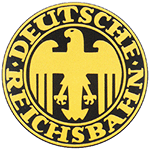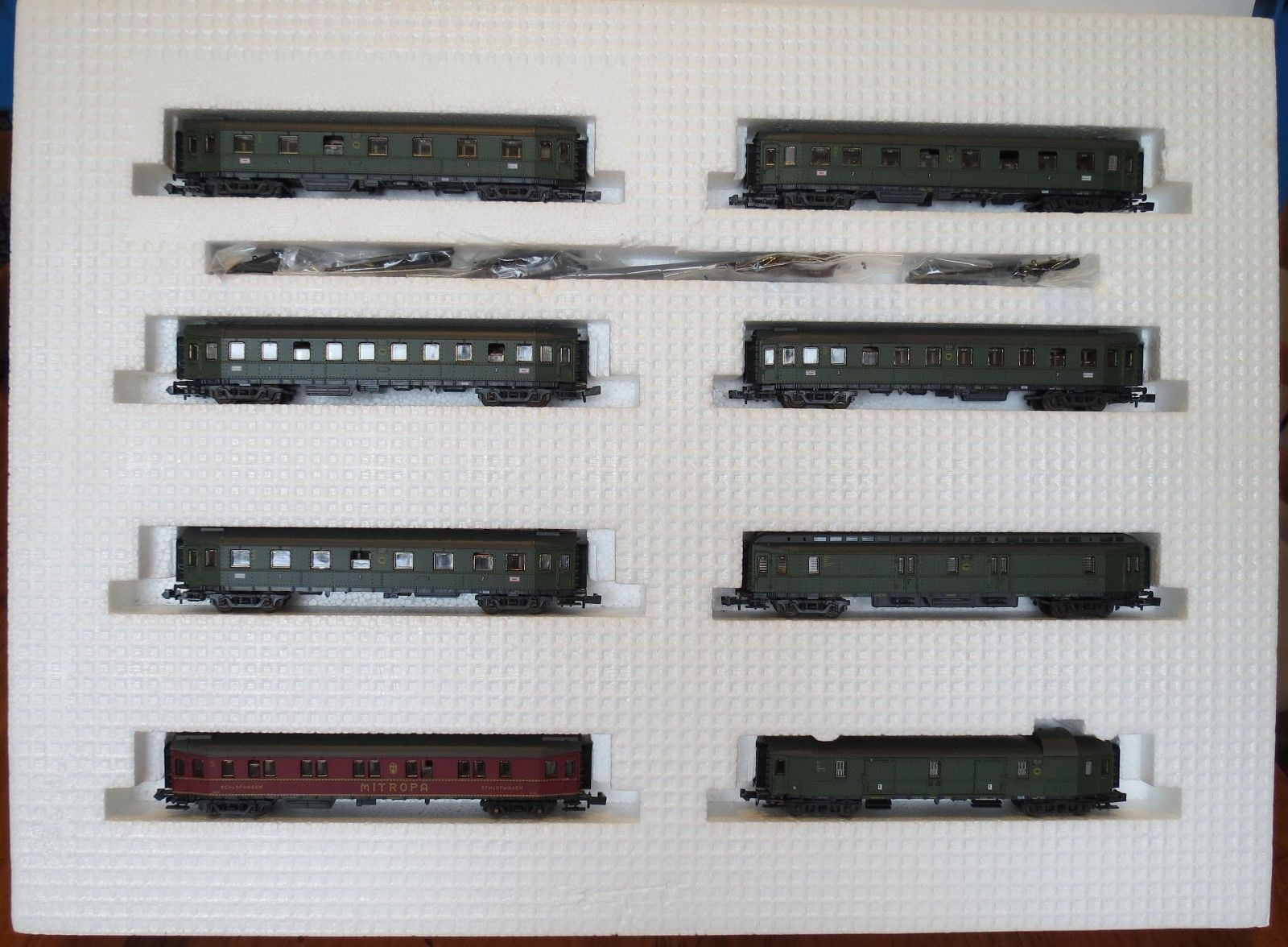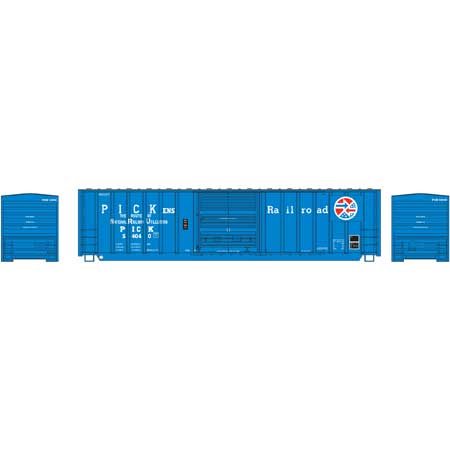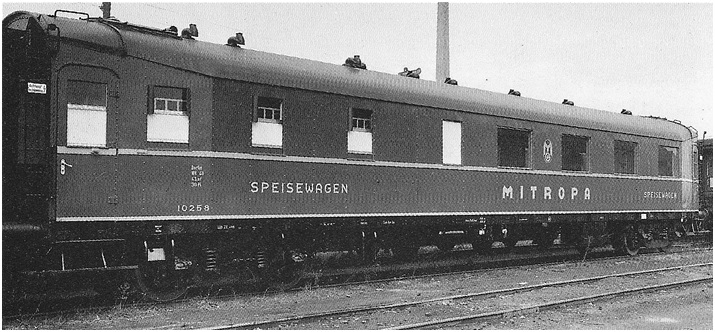Prototype History: "Hechtwagen" / "Pike Cars" - The First Standard Design Cars on the German State Railroad. At the start of the Twenties, when the decision was made to merge the individual state railroads into the German State Railroad Company (DRG), the managers were confronted with an almost unmanageable variety of rolling stock, which caused problems and higher costs in daily operation of a tightly managed firm. The decision was made to standardize both in the awarding of contracts for new locomotives and the purchase of new cars that were urgently necessary in the aftermath of the extreme demands placed on them in the war years. Emphasis was placed on massively lowering costs. Quick results were achieved in the area of passenger cars and as early as 1922 and 1923 the first all-German, newly developed family of cars was ready to be presented to the public: the family of "Hechtwagen" / "Pike Cars" constructed of iron. The name for these very reliable cars came from the wedge-shaped tapering car ends that were already in use on the Saxon State Railroad. However, it turned out that this unusual form was not an improvement either visually or technically and they were discarded in the building plans as early as 1928. In addition to being constructed of iron, another common feature of these cars was the use of wood for interior walls and for lining the ceilings. The cars were laid out with compartments with a side corridor, a sturdy barrel-shaped roof instead of the Prussian clerestory type of roof, ladders on the ends of the cars, and side windows with rather rounded corners. The cars were equipped with electric lighting and "Knorr Kunze S" type air brakes. In 1922, the car program included type A4ü-23 car, 1st class, type B4ü-22 cars, 2nd class, (both types were initially planned only for the "Hapag-Lloyd trains"), type AB4ü-23a/b/c cars, 1st/2nd class, type C4ü-23 cars, 3rd class, and type Pw4ü-23 baggage cars. The latter did not have the standard length of 20,610 mm / 67 feet 7-7/16 inches; they were only 18,840 mm / 61 feet 9-3/4 inches. The baggage cars also differed in having Prussian standard design trucks. The other cars were equipped with trucks of an American design. The "Hechtwagen" or "Pike Cars" could be seen in daily service in express trains all over Germany. Their robust construction was so reliable that in addition to the German Federal Railroad taking over these cars after World War II, other railroads such as the German State Railroad (DR) or the Austrian Federal Railways (ÖBB) also incorporated into their rolling stock the cars still in their areas. The German Federal Railroad retired the originally "German" "Hechtwagen" or "Pike Cars" by the mid-Sixties. Similar designs of Polish origin were still in use for a few more years. Several "Hecht" cars were converted to maintenance cars and were even painted in ocean blue.
Road Name History:  The Deutsche Reichsbahn, also known as the German Reich Railway or the German Imperial Railway, was the name of the German national railway created from the railways of the individual states of the German Empire following the end of World War I.
The Deutsche Reichsbahn, also known as the German Reich Railway or the German Imperial Railway, was the name of the German national railway created from the railways of the individual states of the German Empire following the end of World War I.
The company was founded in 1920 as the Deutsche Reichseisenbahnen when the Weimar Republic, formally known as Deutsches Reich (German Reich, hence the usage of the Reich in the name of the railway), took national control of the German railways, which had previously been run by the German states. In 1924 it was reorganised under the aegis of the Deutsche Reichsbahn-Gesellschaft (DRG), a nominally private railway company, which was 100% owned by the German state. In 1937 the railway was reorganised again as a state authority and given the name Deutsche Reichsbahn (DRB). After the Anschluss in 1938 the DR also took over the Bundesbahn Osterreich (BBO, Federal Railway of Austria).
The East and West German states were founded in 1949. East Germany took over the control of the DR on its territory and continued to use the traditional name Deutsche Reichsbahn, while the railway in West Germany became the Deutsche Bundesbahn (DB, German Federal Railway). The Austrian Osterreichische Bundesbahnen (OBB, Austrian Federal Railways) was founded in 1945, and was given its present name in 1947.
In January 1994, following the German union, the East German Deutsche Reichsbahn merged with the West German Deutsche Bundesbahn to form Germany's new national carrier, Deutsche Bahn AG, technically no longer a government agency but still a 100% state-owned joint stock company.

The company was founded in 1920 as the Deutsche Reichseisenbahnen when the Weimar Republic, formally known as Deutsches Reich (German Reich, hence the usage of the Reich in the name of the railway), took national control of the German railways, which had previously been run by the German states. In 1924 it was reorganised under the aegis of the Deutsche Reichsbahn-Gesellschaft (DRG), a nominally private railway company, which was 100% owned by the German state. In 1937 the railway was reorganised again as a state authority and given the name Deutsche Reichsbahn (DRB). After the Anschluss in 1938 the DR also took over the Bundesbahn Osterreich (BBO, Federal Railway of Austria).
The East and West German states were founded in 1949. East Germany took over the control of the DR on its territory and continued to use the traditional name Deutsche Reichsbahn, while the railway in West Germany became the Deutsche Bundesbahn (DB, German Federal Railway). The Austrian Osterreichische Bundesbahnen (OBB, Austrian Federal Railways) was founded in 1945, and was given its present name in 1947.
In January 1994, following the German union, the East German Deutsche Reichsbahn merged with the West German Deutsche Bundesbahn to form Germany's new national carrier, Deutsche Bahn AG, technically no longer a government agency but still a 100% state-owned joint stock company.
Manufacturer Information:  The company was founded in 1960 by Ing. Heinz Rössler and started with a plastic Minitanks series of military vehicles. After export to the USA became successful, the model line was expanded with model trains in HO scale and the smaller N scale. TT scale was also subsequently added to the product line. The model rail product line covers many European countries including Germany, Belgium, Luxembourg, France, Spain, Austria, Italy, Switzerland, Sweden and the Netherlands, and also the USA.
The company was founded in 1960 by Ing. Heinz Rössler and started with a plastic Minitanks series of military vehicles. After export to the USA became successful, the model line was expanded with model trains in HO scale and the smaller N scale. TT scale was also subsequently added to the product line. The model rail product line covers many European countries including Germany, Belgium, Luxembourg, France, Spain, Austria, Italy, Switzerland, Sweden and the Netherlands, and also the USA.
On July 15, 2005 ROCO Modellspielwaren GmbH was declared bankrupt. From July 25 the company continues as Modelleisenbahn GmbH, but still uses the Roco brand and associated logo. On October 1, 2007, distribution of the 'Minitank' product series was assigned to the German model car manufacturer Herpa.
Since February 2008 Modelleisenbahn also owns Fleischmann, which like Roco had gone bankrupt. The two companies continue as separate brands under Modelleisenbahn GmbH, while benefiting from economies of scale through joined development projects, marketing and procurement.
From Wikipedia

On July 15, 2005 ROCO Modellspielwaren GmbH was declared bankrupt. From July 25 the company continues as Modelleisenbahn GmbH, but still uses the Roco brand and associated logo. On October 1, 2007, distribution of the 'Minitank' product series was assigned to the German model car manufacturer Herpa.
Since February 2008 Modelleisenbahn also owns Fleischmann, which like Roco had gone bankrupt. The two companies continue as separate brands under Modelleisenbahn GmbH, while benefiting from economies of scale through joined development projects, marketing and procurement.
From Wikipedia
Item created by: gdm on 2018-09-26 09:19:08
Last edited by: Alain LM on 2020-11-01 09:58:17
If you see errors or missing data in this entry, please feel free to log in and edit it. Anyone with a Gmail account can log in instantly.
Last edited by: Alain LM on 2020-11-01 09:58:17
If you see errors or missing data in this entry, please feel free to log in and edit it. Anyone with a Gmail account can log in instantly.









